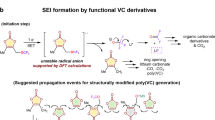Abstract
Oligo(ethylene oxide)-functionalized trialkoxysilanes were synthesized through hydrosilylation reaction by reacting trialkoxysilane with oligo(ethylene oxide) allyl methyl ether using PtO2 as a catalyst. The physical properties of these compounds, such as viscosity, dielectric constant, and ionic conductivity, were characterized. Among them, [3-(2-(2-methoxyethoxy)ethoxy)-propyl]triethoxysilane (TESM2) exhibited a commercial viable ionic conductivity of 1.14 mS cm−1 and a wide electrochemical window of 5.2 V. A preliminary investigation was conducted by using TESM2 as an electrolyte solvent for high-voltage applications in lithium-ion batteries. Using 1 M LiPF6 in TESM2 with 1 vol% vinyl carbonate as an electrolyte, LiCoO2/Li half-cell delivered a specific capacity of 153.9 mAh g−1 and 90 % capacity retention after 80 cycles (3.0–4.35 V, 28 mA g−1); Li1.2Ni0.2Mn0.6O2/Li4Ti5O12 full cell exhibited the initial capacity of 161.3 mAh g−1 and 86 % capacity retention after 30 cycles (0.5–3.1 V, 18 mA g−1).







Similar content being viewed by others
References
Etacheri V, Marom R, Elazari R, Salitra G, Aurbach D (2011) Challenges in the development of advanced Li-ion batteries: a review. Energy Environ Sci 4:3243–3262
Armand M, Tarascon JM (2008) Building better batteries. Nature 451:652–657
Armstrong AR, Holzapfel M, Novak P, Johnson CS, Kang SH, Thackeray MM, Bruce PG (2006) Demonstrating oxygen loss and associated structural reorganization in the lithium battery cathode Li[Ni0.2Li0.2Mn0.6]O2. J Am Chem Soc 128:8694–8698
Lu ZH, MacNeil DD, Dahn JR (2001) Layered cathode materials Li[NixLi(1/3–2x/3)Mn(2/3 − x/3)]O2 for lithium-ion batteries. Electrochem Solid-State Lett 4:A191–A194
Kraytsberg A, Ein-Eli Y (2012) Higher, stronger, better… a review of 5 volt cathode materials for advanced lithium-ion batteries. Adv Energy Mater 2:922–939
Sun YC, Wang ZX, Huang XJ, Chen LQ (2004) Synthesis and electrochemical performance of spinel LiMn2 − x − y Ni x Cr y O4 as 5-V cathode materials for lithium ion batteries. J Power Sources 132:161–165
Kim JH, Myung ST, Sun YK (2004) Molten salt synthesis of LiNi0.5Mn1.5O4 spinel for 5 V class cathode material of Li-ion secondary battery. Electrochim Acta 49:219–227
Zheng JM, Zhu DR, Yang Y, Fung YS (2012) The effects of N-methyl-N-butylpyrrolidinium bis(trifluoromethylsulfonyl)imide-based electrolyte on the electrochemical performance of high capacity cathode material Li[Li0.2Mn0.54Ni0.13Co0.13]O2. Electrochim Acta 59:14–22
Xu K, Angell CA (1998) High anodic stability of a new electrolyte solvent: unsymmetric noncyclic aliphatic sulfone. J Electrochem Soc 145:L70–L72
Sun XG, Angell CA (2009) Doped sulfone electrolytes for high voltage Li-ion cell applications. Electrochem Commun 11:1418–1421
Abu-Lebdeh Y, Davidson I (2009) High-voltage electrolytes based on adiponitrile for Li-ion batteries. J Electrochem Soc 156:A60–A65
Nagahama M, Hasegawa N, Okada S (2010) High voltage performances of Li2NiPO4F cathode with dinitrile-based electrolytes. J Electrochem Soc 157:A748–A752
Takehara M, Tsukimori N, Nanbu N, Ue M, Sasaki Y (2003) Physical and electrolytic properties of fluoroethyl methyl carbonate. Electrochemistry 71:1201–1204
Rossi NAA, West R (2009) Silicon-containing liquid polymer electrolytes for application in lithium ion batteries. Polym Int 58:267–272
Chen ZH, Wang HH, Vissers DR, Zhang LZ, West R, Lyons LJ, Amine K (2008) Kinetic investigation of the solvation of lithium salts in siloxanes. J Phys Chem C 112:2210–2214
Zhang LZ, Zhang ZC, Harring S, Straughan M, Butorac R, Chen ZH, Lyons L, Amine K, West R (2008) Highly conductive trimethylsilyl oligo(ethylene oxide) electrolytes for energy storage applications. J Mater Chem 18:3713–3717
Zhang LZ, Lyons L, Newhouse J, Zhang Z, Straughan M, Chen Z, Amine K, Hamers RJ, West R (2010) Synthesis and characterization of alkylsilane ethers with oligo(ethylene oxide) substituents for safe electrolytes in lithium-ion batteries. J Mater Chem 20:8224–8226
Qin XY, Wang JL, Zhang LZ (2012) Organosilicon based electrolytes for lithium-ion batteries. Prog Chem 24:810–822
Zhong HX, Luo H, Zhao CB, Zhang LZ (2012) Novel organosilicon ionic liquid based electrolytes for supercapacitors. Acta Phys-Chim Sin 28:2641–2647
Xia Q, Wang B, Wu YP, Luo HJ, van Ree TJ (2008) Phenyl tris-2-methoxydiethoxy silane as an additive to PC-based electrolytes for lithium-ion batteries. J Power Sources 180:602–606
Walkowiak M, Waszak D, Schroeder G, Gierczyk B (2008) Polyether-functionalized disiloxanes as new film-forming electrolyte additive for Li-ion cells with graphitic anodes. Electrochem Commun 10:1676–1679
Dong J, Zhang ZC, Kusachi Y, Amine A (2011) J Power Sources 196:2255–2259
Ghosh BD, Lott KF, Ritchie JE (2005) Conductivity dependence of PEG content in an anhydrous proton conducting sol–gel electrolyte. Chem Mater 17:661–669
Assary RS, Curtiss LA, Redfern PC, Zhang Z, Amine K (2011) Computational studies of polysiloxanes: oxidation potentials and decomposition reactions. J Phys Chem C 115:12216–12223
Burns JC, Sinha NN, Coyle DJ, Jain G, VanElzen CM, Lamanna WM, Xiao A, Scott E, Gardner JP, Dahn JR (2012) The impact of varying the concentration of vinylene carbonate electrolyte additive in wound Li-ion cells. J Electrochem Soc 159:A85–A90
Sun XG, Angell CA (2005) New sulfone electrolytes for rechargeable lithium batteries. Part I. Oligoether-containing sulfones. Electrochem Commun 7:261–266
Ohzuku T, Ueda A, Yamamoto N (1995) Zero-strain insertion material of Li[Li1/3Ti5/3]O4 for rechargeable lithium cells. J Electrochem Soc 142:1431–1435
Acknowledgments
This work was supported by the National Science Foundation of China (50973112), the Hundred Talents Program of the Chinese Academy of Sciences (CAS), CAS-Guangdong Collaboration Program (20108), and Science & Technology Project of Guangzhou (11A44061500). Partial financial assistance was also supported by Amperex Technology Limited (China).
Author information
Authors and Affiliations
Corresponding author
Rights and permissions
About this article
Cite this article
Qin, X., Wang, J., Mai, Y. et al. Oligo(ethylene oxide)-functionalized trialkoxysilanes as novel electrolytes for high-voltage lithium-ion batteries. Ionics 19, 1567–1572 (2013). https://doi.org/10.1007/s11581-013-0888-z
Received:
Revised:
Accepted:
Published:
Issue Date:
DOI: https://doi.org/10.1007/s11581-013-0888-z




